PLANETS
Saturn: Unraveling the Mysteries of the Ringed Planet Through Time and Technology
Written By: Mustafa Syed Ahmed
Nov 8th, 2024
In the dark outer reaches of our solar system, the sixth planet from the sun is a ringed colossus with 146 moons in orbit around it. It is a planet so vast that it could comfortably contain more than 750 Earths within its voluminous frame, characterized by distinct cloud bands and a mesmerizing hexagonal pattern at its north pole. Its atmosphere is vivid and ever changing, with a vast array of storms and disturbances routinely ravaging its huge surface. Perhaps the most famous of these is the Great White Spot, a massive storm system that periodically appears in the planet's southern hemisphere, spanning thousands of kilometers. Just through a quick read on sparse details like this, you already may be beginning to understand the wondrous allure of this massive part of our solar system, with all of its enthralling qualities and unique traits. But of course, before unraveling the deeper secrets of the gas giant, we must first address its most striking attribute, its iconic appearance.
Have you ever wondered what those mysterious rings around Saturn are made of or how they formed? You're not alone. For centuries, Saturn remained an enigma that perplexed even the greatest scientific minds. But thanks to the work of early astronomers like Galileo Galilei, we now know Saturn isn't just another bright light in the night sky - it's a planet with dazzling rings and many moons waiting to be explored.
Back in Galileo's day, telescopes were primitive and Saturn itself was misunderstood. When Galileo first observed the planet in 1610, he thought the rings were moons. But as telescopes improved, astronomers realized Saturn's mysterious protrusions were rings made of chunks of ice and rock. It was 17 years after the death of Galileo that the next big breakthrough regarding Saturn was made. In 1659, Dutch astronomer Christiaan Huygens, armed with an improved telescope, directed his gaze towards Saturn once again. This time, his observations and deductions revolutionized our understanding of the planet. Huygens correctly deduced that the two bodies surrounding Saturn were not moons but a single flat ring – a breakthrough that fundamentally altered our perception of Saturn's ring system. In addition to this revelation, Huygens made another significant discovery during his observations of Saturn; he identified and named one of Saturn's largest moons, Titan, which would later become a focal point of scientific intrigue.

This captivating animation presents a compilation of Hubble Space Telescope images that vividly depict the evolving visage of Saturn during the waning days of the summer season in its northern hemisphere. These stunning visuals were captured over the course of three years, spanning from 2018 to 2020. (Image credit: NASA/ESA/STScI/A. Simon/R. Roth)
Another 16 years after Huygens' groundbreaking work, Italian astronomer Jean-Dominique Cassini made his own mark on Saturn's exploration. Cassini discovered the Cassini division, a prominent gap measuring approximately 4800 kilometers between the rings. This discovery would pave the way for further investigations into the intricate structure of Saturn's ring system. Cassini's meticulous observations led to the division of the ring into multiple subsections, with two prominent segments labeled as Ring A and Ring B. Although it is now believed by scientists that Saturn possesses over 1000 rings, considering the technological limitations of the time, Cassini's achievements were truly remarkable.
Fast forward to today, and we've sent spacecraft to orbit Saturn, studying its rings and moons up close. Missions like Cassini have revealed wonders beyond Galileo's wildest dreams and given us a new appreciation for the planet that has intrigued skygazers for ages. Saturn still holds mysteries, but thanks to the work of early astronomers and today's scientists, we've come a long way in understanding this jewel of the solar system.
Modern Explorations of Saturn
In the quest to unlock the mysteries of Saturn, modern astronomers have embarked on extraordinary missions that have deepened our understanding of this captivating planet. Building upon the foundations laid by early astronomers like Galileo Galilei, today's scientists have harnessed cutting-edge technology to delve into the secrets held by Saturn and its celestial companions.
Advancements in space exploration have allowed us to send spacecraft to orbit Saturn, providing us with unprecedented access to its enigmatic rings and intriguing moons. One such mission, Cassini, has revolutionized our perception of this gas giant. Equipped with state-of-the-art instruments and cameras, Cassini has captured breathtaking images and collected invaluable data, pushing the boundaries of our knowledge.
As Cassini ventured closer to Saturn, its powerful lenses revealed a mesmerizing tapestry of rings, intricately composed of cosmic debris ranging from icy particles to rocky fragments. These rings, once thought to be moons by Galileo, now mesmerize us with their stunning beauty and intricate dynamics. Scientists have meticulously studied the composition and structure of these rings, uncovering their role in Saturn's captivating dance through space. Beyond the rings, Cassini's journey unveiled a treasure trove of moons. Among them, Titan has emerged as a captivating world in its own right. This moon, enveloped in a thick atmosphere, boasts lakes of liquid methane and ethane, captivating scientists with the potential for extraterrestrial life. Enceladus, another of Saturn's moons, has captivated our attention with its towering geysers, hinting at the existence of a subsurface ocean and the possibility of habitable environments.
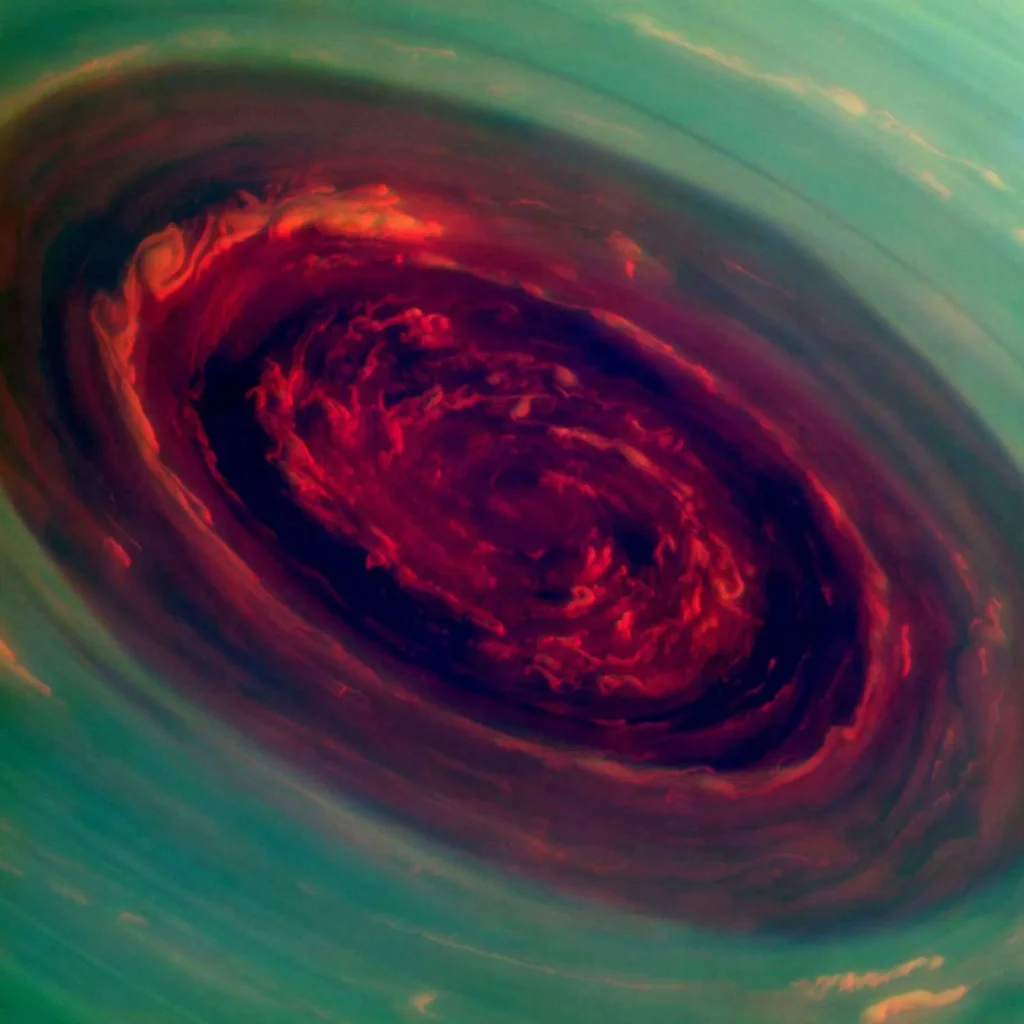
The spinning vortex of Saturn's north polar storm on Nov. 27, 2012. Taken using a combination of spectral filters sensitive to wavelengths of near-infrared light. (Photo Credit: NASA/JPL/Space Science Institute)
In the centuries since, we've learned an incredible amount about Saturn and its rings and moons. We now know the rings are made of chunks of ice and rock that range in size from tiny grains of sand to as large as a house. Missions like Cassini have revealed wonders like the geysers erupting from Saturn's moon Enceladus and the strange hexagonal storm at Saturn's north pole. But it all began with those first curious observations by Galileo, who unlocked the mysteries of Saturn and forever changed how we understand our solar system.
Moons Galore: The Diverse Satellites of the Ringed Planet

Thanks to NASA’s Cassini spacecraft, we know more about Saturn’s moons than ever before. The spacecraft even discovered more than half a dozen moons during its 13-year tour around the planet.(Photo Credit: NASA)
Saturn’s moons are as diverse as they are numerous. The ringed planet hosts over 150 known satellites, ranging from tiny moonlets less than a mile across to massive Titan, bigger than Mercury. Early astronomers like Galileo were stunned when they first observed Saturn’s moons through primitive telescopes. These natural satellites opened up a whole new frontier of discovery and revealed insights into Saturn’s origins.
Titan: A Mysterious Orange World
Titan, Saturn’s largest moon, is a strange place. It’s the only moon in the solar system with a dense atmosphere, composed primarily of nitrogen like Earth’s but also rich in methane. This gives Titan’s sky an orange hue. Galileo first spotted Titan in 1610, though he mistook it for a star. Titan remained mysterious for centuries until the Cassini spacecraft arrived in 2004. Cassini discovered liquid methane seas on Titan’s surface, sand dunes, and evidence of geological activity. Titan may even have the conditions needed for exotic forms of life.
Icy Wonders: Enceladus and Others
Enceladus, one of Saturn’s mid-sized moons, is geologically active and erupts towering geysers of water ice and vapor from its south pole. Enceladus could have an internal ocean of liquid water, making it a prime target in the search for extraterrestrial life. Other icy moons like Mimas, Tethys, and Dione are pockmarked with craters from ancient impacts. Rhea, Saturn’s second largest moon, has a series of deep canyons across its surface.
Shepherd Moons and Moonlets
Some of Saturn’s smallest moons, like Pan, Daphnis, Atlas, Prometheus, and Pandora, interact with and influence the planet’s ring system. Prometheus and Pandora are “shepherd moons” that herd ring particles into narrow bands. Pan and Daphnis disturb ring material as they travel through the rings, creating ripples and waves. Tiny moonlets embedded in the rings themselves were first detected in images from Voyager and Cassini. Studying these moons helps scientists understand the origin and evolution of Saturn’s rings. Saturn’s moons represent an array of worlds in miniature. From hazy Titan to the icy Enceladus, each moon is a unique world shaped by its interactions with the ringed planet and space environment. Exploring Saturn’s satellites has revolutionized our understanding of planet formation and even gives us clues to finding habitable worlds across the galaxy.

The stunning images capture and reveal intricate details of Saturn's moon, offering a remarkable glimpse into its features and characteristics. (Photo Credit: NASA)
Advances in Telescope Technology Enabled Detailed Studies of Saturn
As astronomical tools advanced, our understanding of Saturn grew by leaps and bounds. Early telescopes were limited to observing Saturn as a tiny yellowish dot in the night sky. But as lens grinding and mirror polishing techniques improved, telescopes enabled astronomers to study Saturn in far greater detail.
In the early 1600s, Galileo Galilei first observed Saturn through a refracting telescope he built himself. His crude telescope magnified objects about 30 times, enabling him to see Saturn as an oblong shape—though he mistakenly thought Saturn's rings were two moons on either side of the planet. Decades later, as telescope lenses improved, astronomers realized Galileo's “moons” were actually rings encircling Saturn.

A c. 1900 painting by Henry-Julien Detouche showing Galileo (1564-1642) demonstrating his telescope (which he built c. 1608) to Leonardo Donato, Doge of Venice
In the 1700s, telescope mirrors began replacing lenses, allowing for higher magnification. William Herschel built powerful reflecting telescopes, and in 1789 he discovered Saturn's largest moon, Titan, and observed a narrow gap between Saturn's A and B rings. Herschel proposed the rings were composed of countless small particles orbiting Saturn. His observations revolutionized theories about the nature and origin of Saturn's ring system.
Paving the Way for Modern Exploration
Spacecraft missions to Saturn have revolutionized our understanding of the ringed planet. Early flybys of Saturn by Pioneer 11 in 1979 and Voyager 1 and 2 in 1980 and 1981, respectively, revealed groundbreaking discoveries about Saturn’s moons and ring system that challenged previous theories. These encounters paved the way for the Cassini orbiter, which conducted a 13-year orbital tour of Saturn starting in 2004.
In September 1979, Pioneer 11 marked a pivotal moment in space exploration by becoming the first spacecraft to journey to Saturn. During this historic mission, it unveiled the mysteries of the ringed giant, discovering Saturn's intricate F ring, extensively studying its magnetosphere, and pioneering observations of Titan, Saturn's largest moon. This groundbreaking endeavor not only provided a wealth of data on Saturn's unique features but also set the stage for subsequent missions, expanding our understanding of this enigmatic planet and its captivating moon.
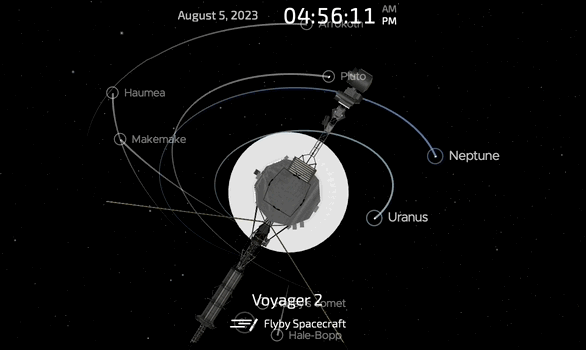
NASA shows the real time location of Voyager-2 on their website. The one above shows the location for the date August 5th, 2023. (Photo Credit: NASA)
The twin Voyager spacecraft, Voyager 1 and Voyager 2, executed a pair of remarkable flybys of Saturn in 1980 and 1981, and their findings significantly enriched our comprehension of this ringed giant and its diverse moon system. During this extraordinary journey, Voyager 1 made a pivotal discovery by identifying Saturn's G ring, contributing to the growing understanding of Saturn's intricate ring system. Furthermore, both Voyager probes played a crucial role in ascertaining that Saturn's rings consist predominantly of small ice and rock particles, a finding that reshaped our comprehension of this iconic feature. Meanwhile, Voyager 2 concentrated its efforts on studying one of Saturn's most enigmatic moons, Enceladus. This moon was scrutinized with great attention, revealing an astonishing landscape defined by a complex network of fissures and ridges. Voyager 2's instruments also detected an intriguing heat signature emanating from Enceladus, hinting at the presence of internal heat sources and potential geological activity that would captivate the interest of future missions, particularly the Cassini-Huygens mission.
Adding to the scientific wealth, the Voyager missions expanded Saturn's known moon count by discovering new moons orbiting the planet. These newfound companions elevated Saturn's total moon tally to 17, each with its own distinct characteristics and orbital dynamics. The Voyager missions, with their pioneering contributions, played an indispensable role in laying the groundwork for subsequent explorations of the outer solar system and deepening our understanding of Saturn's multifaceted environment.

Before it met its doom, the spacecraft gathered data that puts to rest a long-standing mystery about the sixth planet from our Sun. (Photo Credit: NASA)
The Cassini orbiter mission represented a giant leap forward in our exploration of Saturn. Cassini entered into orbit around Saturn on the 1st of July, 2004 and conducted close flybys of Saturn’s moons, including Titan and Enceladus. Cassini revealed that Enceladus harbors an ocean of liquid water beneath its icy surface and could potentially support life. Cassini also took high-resolution images of Saturn’s rings, confirming that they are made up of countless small particles of ice and rock that orbit around Saturn. After 13 years orbiting Saturn, Cassini was sent on a collision course into Saturn on the 15th of September, 2017. This “grand finale” dive into Saturn’s atmosphere marked the end of one of the most successful planetary science missions ever attempted. The discoveries from Cassini have reshaped our understanding of Saturn and its potential to harbor habitable environments in our solar system. Future missions may build upon Cassini’s revelations to conduct more in-depth studies of Saturn and its moons.
The Cassini-Huygens Mission: Revelations About Saturn's Environment
The Cassini-Huygens mission was one of the most ambitious explorations of Saturn ever attempted. Launched in 1997, the Cassini orbiter and Huygens lander gave us an unprecedented view into Saturn’s environment. After nearly 20 years in space, Cassini plunged into Saturn's atmosphere in September 2017, ending its incredibly successful mission. Cassini’s discoveries shattered many preconceptions about Saturn. It found geysers of water ice and organic molecules erupting from Enceladus’ south pole, revealing an ocean of liquid water beneath the moon’s icy surface. This makes Enceladus one of the most promising places in the solar system to search for extraterrestrial life.
Cassini also spotted massive storm systems in Saturn’s atmosphere, including the famous hexagonal jet stream circling Saturn's north pole. The spacecraft observed lightning flashes, powerful enough to light up Saturn's rings. It measured the depth of Saturn’s banded cloud layers, and found that Saturn's winds blow at over 1,100 miles per hour. These revelations have transformed our understanding of Saturn and its moons. We now know that Saturn’s environment could potentially support life, and harbor exotic forms of chemistry not found anywhere else. The Cassini mission ended, but its discoveries will guide future explorers to unlock more mysteries in Saturn's realm.
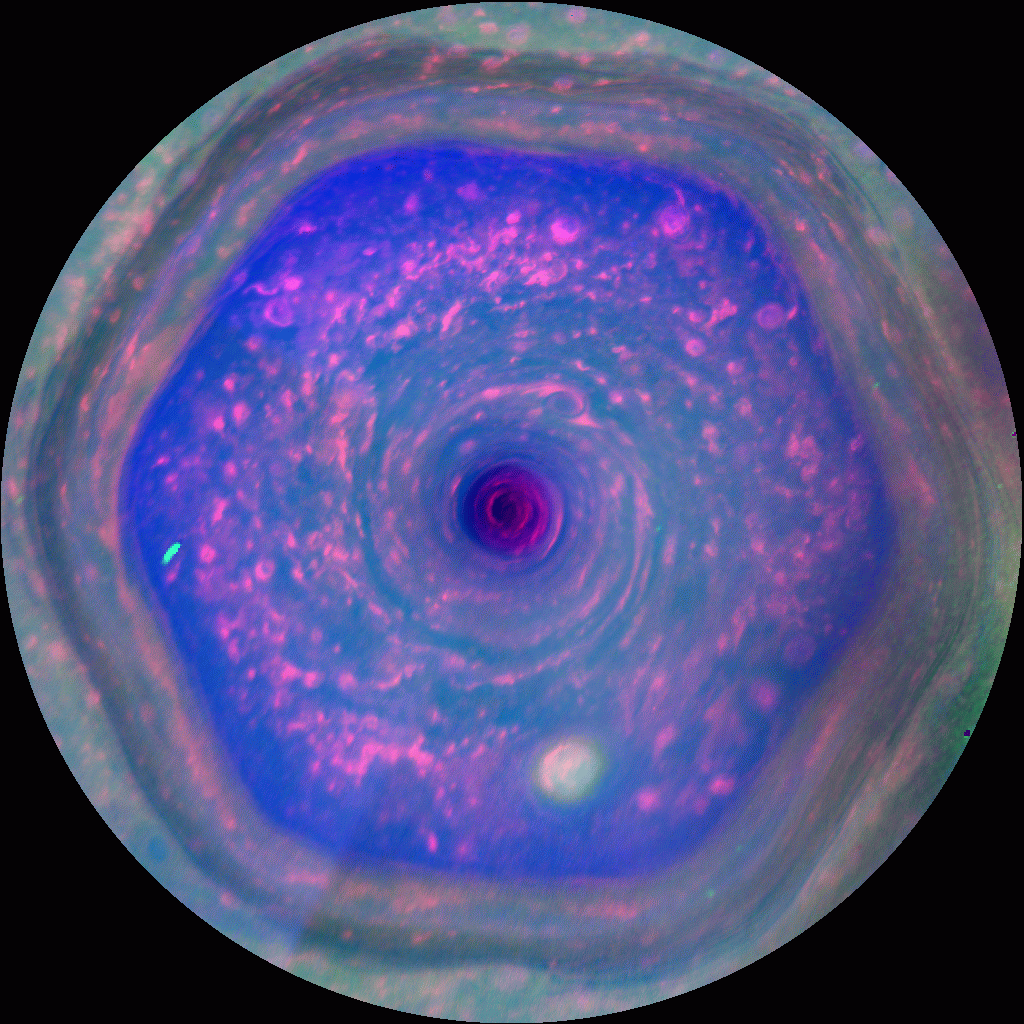
This colorful view from NASA's Cassini mission is the highest-resolution view of the unique six-sided jet stream at Saturn's north pole known as "the hexagon." (Photo Credit: NASA)
Cassini's 13-year exploration of the Saturn system has revolutionized our understanding of the planet, its stunning rings and magnetosphere, and its amazing moons. It has been a very successful joint endeavor between NASA, ESA, and ASI. The mission leaves behind an enduring legacy of discovery that will feed scientific curiosity for decades to come
Upcoming Missions and Future Possibilities
The future is bright for unlocking more of Saturn's mysteries. With new technologies and ambitious missions on the horizon, we're poised to gain a deeper understanding of this enigmatic planet. Upcoming Missions NASA's Cassini spacecraft studied Saturn for over a decade before plunging into its atmosphere in 2017. While Cassini revealed groundbreaking insights, its mission has ended. New missions are being planned to pick up where Cassini left off.
The proposed Dragonfly mission would send a rotorcraft to explore Saturn's largest moon Titan. The craft could fly to dozens of locations on Titan, sampling its exotic atmosphere and searching for signs of habitability. If approved, Dragonfly could launch in the mid 2020s and arrive at Titan in the 2030s. ESA's proposed Enceladus Life Finder (ELF) mission would send a spacecraft to study Saturn's icy moon Enceladus, which has a subsurface ocean and may be habitable. ELF would analyze Enceladus' plumes to search for biological molecules and better understand its ocean. The mission could launch in the 2020s if funded.
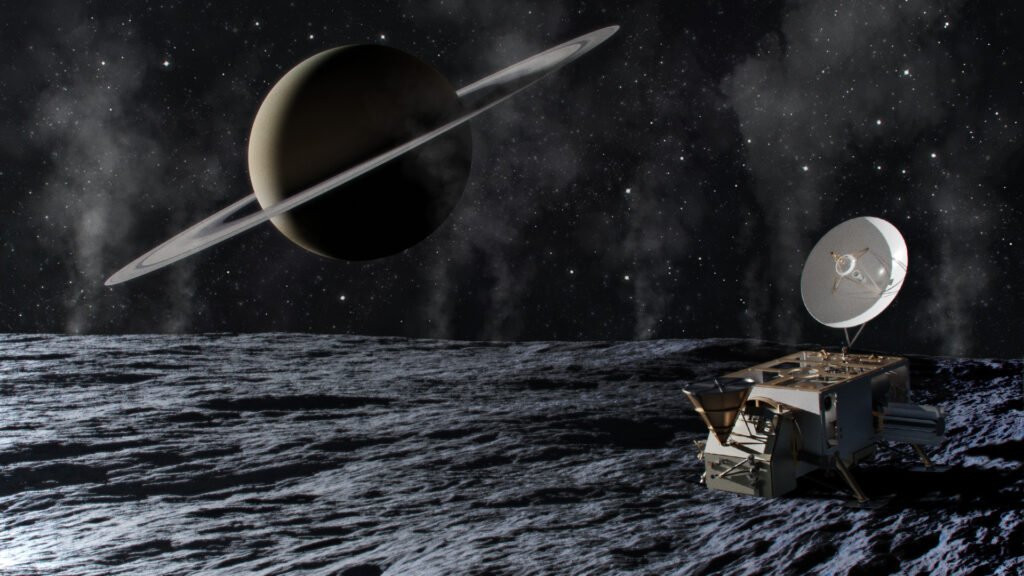
An artist's depiction of the Enceladus Orbilander mission concept. (Image credit: Johns Hopkins Applied Physics Laboratory)
Future orbiters could provide a closer look at Saturn's rings and inner moons. Landers on Titan or Enceladus could explore their surfaces and search for life. With more advanced propulsion like solar sails, we could reach Saturn faster and carry more instruments. As technologies progress, we'll gain insights into Saturn's interior, atmosphere, magnetosphere and auroras. Improved telescopes will allow more detailed observations from Earth. Breakthroughs in fields like astrobiology could help us analyze Saturn's moons for signs of life.
Decades from now, we may send spacecraft to dive into the atmospheres of Saturn and its moons or even land hot air balloon probes on Titan. While far-off, these concepts show the potential for unlocking Saturn's remaining mysteries if we continue advancing our technologies and exploring the unknown. The future of Saturn exploration is bright. By pushing the boundaries of human achievement, we'll gain a deeper understanding of Saturn's wonders and its potential habitability. What we discover could reshape our place in the universe. The golden age of Saturn science has only just begun.
Saturn's Significance: Its Role in Understanding Our Solar System
Saturn holds a special place in our understanding of the solar system. For early astronomers, Saturn was an enigma that challenged beliefs about the nature of the heavens. As telescopes advanced, Saturn revealed its mysteries and expanded our comprehension of celestial mechanics. The famed astronomer Galileo Galilei was the first to observe Saturn through a telescope in 1610. However, the optics were too crude for him to clearly see its rings. He thought Saturn seemed to have "ears". Decades later, Christian Huygens proposed that Saturn was encircled by rings. Additional observations confirmed this theory. The rings revolutionized thinking about the solar system by demonstrating that celestial bodies could have complex shapes and structures.
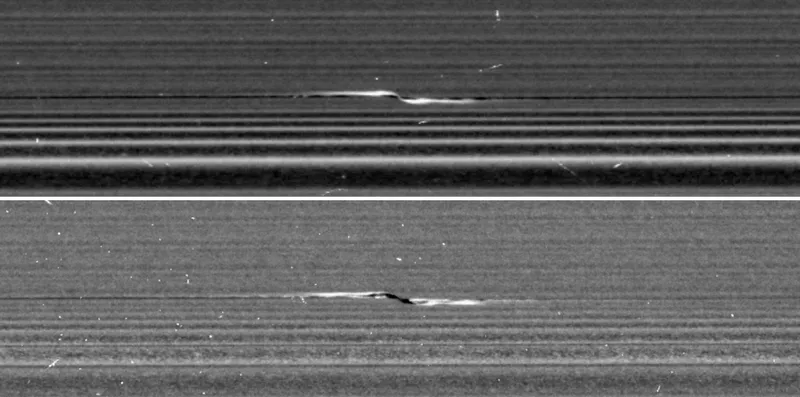
NASA's Cassini spacecraft captured these views of a propeller feature in Saturn's A ring on 21 February 2017. Credit: NASA
Exploring Saturn and its moons has been a high priority for space agencies. In the 1970s and 1980s, Pioneer 11 and Voyagers 1 and 2 conducted flybys of Saturn, discovering new moons and gaining insights into its ring system and magnetosphere. The CassiniHuygens mission was a groundbreaking joint project between NASA, ESA and the Italian space agency that orbited Saturn from 2004 to 2017. It deployed the Huygens probe to land on Titan, Saturn's largest moon. Cassini discovered new moons, observed seasonal changes and revealed never-before-seen details of Saturn's rings and auroras.
Ongoing observations of Saturn by telescopes and spacecraft have revealed a world of unparalleled beauty and scientific significance. Saturn's stunning ring system is a natural wonder that continues to captivate astronomers and the public alike. Its many moons, including Titan with its dense atmosphere and liquid methane lakes, suggest possibilities for habitability in the outer solar system. Saturn's magnetosphere provides opportunities to study magnetic reconnection and solar wind interactions. Future missions may explore Saturn's interior, life-hosting potential, and role in solar system formation.
Conclusion
So there you have it - a glimpse into how early astronomers unlocked the mysteries of Saturn and transformed our understanding of the cosmos. Thanks to their pioneering observations and stubborn persistence in the face of skepticism, we now know Saturn as a jewel of the solar system with its dazzling ring system and fleet of moons.
The explorations of Saturn are a testament to human curiosity and ingenuity. Despite the limitations of technology centuries ago, astronomers like Galileo were determined to peer into the unknown. Their discoveries sparked wonder and reshaped our place in the universe. Though Saturn may still hold secrets yet to be revealed, we have those early stargazers to thank for first unveiling the celestial spectacle of the ringed planet. Their legacy lives on today in the scientists and engineers who continue the quest to explore the farthest reaches of space. So the next time you gaze up at the night sky and spot a bright light with a golden glow, think of the astronomers who made Saturn less mysterious and more marvelous. It is only through their persistence and ingenuity that we now embark further outward, deeper into the cosmic abyss surrounding our little planet. In sure methodical steps, we build our knowledge through the ages so that the next generation of awe-struck stargazers can use the past to soar higher into the future. Perhaps this is best understood in the way Isaac Newton famously puts it:
“If I have seen further it is by standing on the shoulders of Giants.”
Subscribe To Our Newsletter
Receive amazing space news and stories that are hot off the press and ready to be read by thousands of people all around the world.
